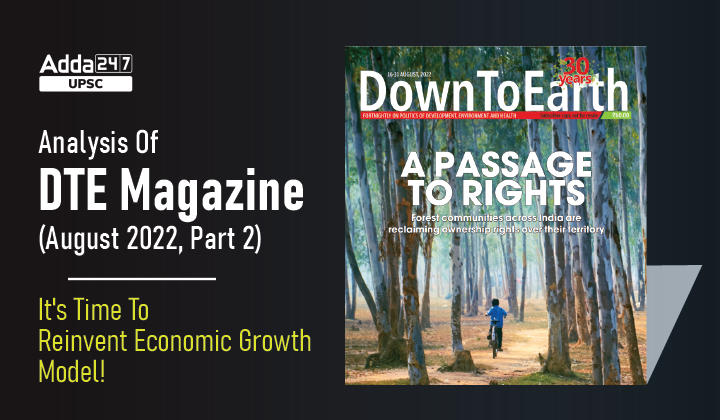Table of Contents
Down To Earth Magazine is a fortnightly magazine focusing on politics of environment and development, published in New Delhi, India.
UPSC Previous years’ questions on Development, Environment, Health and Disaster Management give us a clear idea about the increased importance of Down To Earth Magazine.
Down To Earth Magazine is one of the most important and indispensable source for UPSC Civil Services Exam Preparation. Keeping this in mind, here, we come with ”Gist Of Down To Earth Magazine” which covers important environmental current affairs articles in smooth pointed form, keeping in mind the demand of UPSC aspirants.
Introduction
- Climate Change is an existential threat but we continue to deny the need for drastic emission reduction, that too in a world where millions still need the right to development.
- In India, the poor, already surviving on the margins, are severely impacted by extreme weather events. They are the first victims of climate change even if they have not contributed to the stock of greenhouse gases in the atmosphere.
- So, as we move ahead, we must recognise the imperative of climate justice.
The Urgency of Reinventing Economic Growth Model
- Carbon dioxide (CO2 ) has a long residence time in the atmosphere and so, what is emitted in the past has accumulated and will “force” temperatures to rise.
- Then, CO2 is linked to the way the world runs the economy—fossil fuels (coal or gas) are still determinants of growth.
- Most importantly, millions of people are still waiting to get the benefits of economic progress—which means access to affordable energy.
- And, this at a time when the world has literally run out of carbon space to accommodate their need for development.
What is a Green Economy?
- A green economy is defined as low carbon, resource efficient and socially inclusive.
- In a green economy, growth in employment and income are driven by public and private investment into such economic activities, infrastructure and assets that allow reduced carbon emissions and pollution, enhanced energy and resource efficiency, and prevention of the loss of biodiversity and ecosystem services.
How can “growth” be reinvented so that it is low-carbon, sustainable and yet affordable?
- It is not enough to berate and bully the emerging world countries into action. For far too long, the world has worked overtime to erase or dilute climate equity in the negotiations.
- The world should no longer dilly-dally around with empty promises of net-zero targets for 2050. It must discuss how countries will front-load emission reductions for 2030.
- The “old” industrialised countries and new entrant China have appropriated 73 per cent of the carbon space till 2019, and, even with the reduction targets announced, will occupy 70 per cent by 2030.
- This is why future actions must accept the reality of climate equity and use it to drive economic growth. If we do this, then the opportunity of real change opens up—if we invest today in the poorest economies they can grow without pollution. For instance, the energy needs of the poorest in the world.
Did we achieve much through Paris Agreement?
- The much-lauded 2015 Paris Agreement got rid of the very concept of historical emissions; it consigned climate justice to a postscript.
- It even removed the idea of “compensation” for the loss and damage suffered because of climate change.
- Worse, it created a weak and meaningless framework of climate action that would depend on what a country could do; not what it was expected to do based on its contribution to the stock of emissions or fair share.
- It should not surprise us then that the sum of the nationally determined contributions (NDC)—UN jargon for national reduction targets—takes the world towards a minimum of a 3°C temperature rise or more.
The way ahead
- The way ahead would would be to use clean renewables to meet the needs of these households, which are still outside the fossil fuel energy system. But the cost of renewable energy is beyond their affordability.
- So the world must not preach the need for energy transitions but pay for these to happen—today.
- This is where the discussions on markets—Article 6 of the Paris Agreement—should be put to work.
- The current effort is to find smart and cheap ways to build a market instrument that will reduce the cost of carbon purchase from the developing world.
- A repeat of the complicated, convoluted and cheap Clean Development Mechanism (CDM) must not be allowed.
- Instead, market instruments should be used for transformational action so that projects that will bring “big bang” carbon reductions can be paid for through this instrument.
- For instance, the provision of clean energy through millions of mini-grids in the world of the poorest. In this way, the market will be by public policy and intent, and not left to discover new scams in the name of carbon offsets.
Conclusion
The fact is, we have lost precious time in finding “smart” ways to do as little as possible to reduce greenhouse gas emissions and it is time this stopped. We need to drive policies knowing that we live in an interdependent world, where cooperation is critical, and that ensuring this requires fairness and justice. Climate change is our biggest challenge yet as a human race and it is time we stood up to it.



 TSPSC Group 1 Question Paper 2024, Downl...
TSPSC Group 1 Question Paper 2024, Downl...
 TSPSC Group 1 Answer key 2024 Out, Downl...
TSPSC Group 1 Answer key 2024 Out, Downl...
 UPSC Prelims 2024 Question Paper, Downlo...
UPSC Prelims 2024 Question Paper, Downlo...
